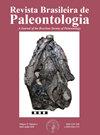Anatomical review o Eira Barbara (Carnivora, Mustelidae) from the Quaternary of Southwestern Brazilian Amazonia
IF 0.6
4区 地球科学
Q4 PALEONTOLOGY
引用次数: 1
Abstract
Most species of mustelids currently found in South America descend from North American immigrants that arrived during the Great American Biotic Interchange, following the rise of the Isthmus of Panama. However, previous works indicate that the genus Eira arrived in South America before this event, through an island bridge in Central America. The tayra Eira barbara (Mustelidae, Carnivora), the only species of the genus, currently has a wide geographic distribution, from Mexico to northern Argentina. Here, we redescribe a fossil of E. barbara collected close to the Municipality of Marechal Thaumaturgo, Acre State, Brazil. The southwestern Brazilian Amazonia is mostly characterized by the older sediments of Solimoes Formation (Neogene deposits), although on the riverbanks of the Upper Jurua River a typical Quaternary vertebrate fauna is also found, mainly represented by fossil mammals. The specimen UFAC PV-36 is a right hemimandible with the p4 preserved in situ, and it was compared to fossil and extant specimens of E. barbara, as well as with other carnivorans. The review of the fossil record shows that this taxon is restricted to the Quaternary of Brazil, in the states of Bahia, Minas Gerais and Acre, and of Argentina, in the Entre Rios Province. In this way, our study contributes to a better understanding of the origin and distribution of the genus in the Quaternary of South America.巴西亚马逊西南部第四纪Eira Barbara(食肉目,鼬科)的解剖学回顾
目前在南美洲发现的大多数鼬科动物都是北美移民的后代,他们是在巴拿马地峡崛起后的大美洲生物交流期间抵达的。然而,先前的研究表明,艾拉属在这一事件之前通过中美洲的一座岛桥抵达南美洲。巴巴拉鼬科(Mustelidae,Carnivora)是该属唯一的物种,目前地理分布广泛,从墨西哥到阿根廷北部。在这里,我们重新绘制了在巴西阿克里州Marechal Thaumaturgo市附近采集的E.barbara化石。巴西西南部亚马逊地区主要以Solimoes组的较老沉积物(第三纪沉积物)为特征,尽管在Jurua河上游的河岸上也发现了典型的第四纪脊椎动物,主要以哺乳动物化石为代表。UFAC PV-36标本是一个右半下颌,p4原位保存,并与E.barbara的化石和现存标本以及其他食肉动物进行了比较。对化石记录的审查表明,该分类单元仅限于巴西巴伊亚州、米纳斯吉拉斯州和阿克里州的第四纪,以及阿根廷恩特雷里奥斯省的第四纪。这样,我们的研究有助于更好地了解该属在南美洲第四纪的起源和分布。
本文章由计算机程序翻译,如有差异,请以英文原文为准。
求助全文
约1分钟内获得全文
求助全文
来源期刊

Revista Brasileira De Paleontologia
PALEONTOLOGY-
CiteScore
1.60
自引率
14.30%
发文量
25
审稿时长
>12 weeks
期刊介绍:
It publishes original contributions on all aspects of Paleontology. Papers are written in English, Spanish, or Portuguese and are reviewed by international experts.
 求助内容:
求助内容: 应助结果提醒方式:
应助结果提醒方式:


